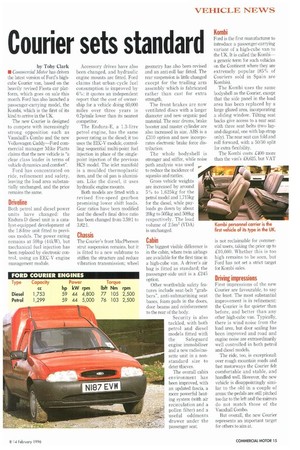Courier sets standard
Page 17

If you've noticed an error in this article please click here to report it so we can fix it.
by Toby Clark
• Commercial Motor has driven the latest version of Ford's highcube Courier van, based on the heavily revised Fiesta car platform, which goes on sale this month. Ford has also launched a passenger-carrying model, the Kombi, which is the first of its kind to arrive in the UK.
The new Courier is designed to compete with increasingly strong opposition such as Vauxhall's Combo and the new Volkswagen Caddy—Ford commercial manager Mike Platts claims that the new vehicle is "a clear class leader in terms of vehicle dynamics and comfort".
Ford has concentrated on ride, refinement and safety, leaving the load area substantially unchanged, and the price remains the same.
Driveline
Both petrol and diesel power units have changed: the Endura-D diesel unit is a catalyst-equipped development of the 1.8-litre unit fitted to previous models. The power rating remains at 59hp (44kW), but mechanical fuel injection has been replaced by electronic control, using an EEC-V engine management module. Accessory drives have also been changed, and hydraulic engine mounts arc fitted, Ford claims that urban-cycle fuel consumption is improved by 6%: it quotes an independent report that the cost of ownership for a vehicle doing 60,000 miles over three years is 0.7p/mile lower than its nearest competitor.
The Endura-E, a 1.3-litre petrol engine, has the same power rating as the diesel; it too uses the EEC-V module, controlling sequential multi-point fuel injection in place of the singlepoint injection of the previous HCS model. The inlet manifold is a moulded thermoplastic item, and the oil pan is aluminium. Like the diesel, it uses hydraulic engine mounts.
Both models are fitted with a revised five-speed gearbox promising lower shift loads. Gear ratios have been modified and the diesel's final drive ratio has been changed from 3.59:1 to 3.82:1.
Chassis
The Courier's front MacPherson strut suspension remains, but it is fitted to a new subframe to stiffen the structure and reduce vibration transmission; wheel geometry has also been revised and an anti-roll bar fitted, The rear suspension is little changed except for the trailing arm assembly which is fabricated rather than cast for extra strength.
The front brakes are now ventilated discs with a larger diameter and new organic pad material. The rear drums, brake booster and master cylinder are also increased in size. ABS is a 1310 option and now incorporates electronic brake force distribution.
The whole bodyshell is stronger and stiffer, while noise path analysis was used to reduce the incidence of squeaks and rattles.
Gross vehicle weights are increased by around 5% to 1.625kg for the petrol model and 1,715kg for the diesel, while payloads go down by about 20kg to 505kg and 509kg respectively. The load volume of 2.5m3 (VDA) is unchanged.
Cabin
The biggest visible difference is in the cabin, where twin airbags are available for the first time in a high-cube van. A driver's air bag is fitted as standard; the passenger-side unit is a 4245 option.
Other worthwhile safety features include seat-belt "grabbers", anti-submarining seat bases, foam pads in the doors, door beams and reinforcement to the rear of the body.
Security is also tackled, with both petrol and diesel models fitted with the Safeguard engine immobiliser and a new radio/cassette unit in a nonstandard size to deter thieves.
The overall cabin environment has been improved, with an updated fascia, a more powerful heating system (with air recirculation and a pollen filter) and a useful oddments drawer under the passenger seat.
Kombi
Ford is the first manufacturer to introduce a passenger-carrying variant of a high-cube van to the UK. It is called the Kombi a generic term for such vehicles on the Continent where they are extremely popular (85% of Couriers sold in Spain are Kombis).
The Kombi uses the same bodysliell as the Courier, except that the side panel in the load area has been replaced by a large glazed area, incorporating a sliding window. Tilting seat backs give access to a rear seat with three seat belts (two lapand-diagonal, one with lap strap only). The rear seat can fold and roll forward, with a 50/50 split for extra flexibility.
The Kombi costs 4400 more than the van's 48,625, but VAT is not reclaimable for commercial users, taking the price up to 110,600. Whether this is too high remains to be seen, but Ford has not set a strict target for Kombi sales.
Onving impressions
First impressions of the new Courier are favourable, to say the least. The most substantial improvement is in refinement: the Courier is far quieter than before, and better than any other high-cube van. Typically, there is wind noise from the load area, but door sealing has been improved and road and engine noise are extraordinarily well controlled in both petrol and diesel models.
The ride, too, is exceptional: over rough mountain roads and fast motorways the Courier felt comfortable and stable, and handled well. However, the new vehicle is disappointingly similar to the old in a couple of areas: the pedals are still pitched too far to the left and the min-ors do not match those of the Vauxhall Combo.
But overall, the new Courier represents an important target for others to aim at.




































































































